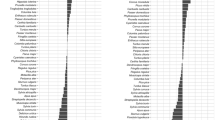Abstract
Habitat edges can have a number of effects on populations, including modifying their patterns of dispersal. Dispersal patterns can influence population dynamics. In this paper, we explore the possible effects of a pattern of dispersal where the response of organisms to the boundary of a habitat patch depends on their local density. We model a population of organisms diffusing and growing logistically inside a patch, but with the likelihood of an individual crossing the patch boundary to leave the patch decreasing as the local density of conspecifics within the patch increases. Such behavior at patch boundaries has been observed among Glanville fritillary butterflies, and has been proposed as a mechanism for generating an Allee effect at the patch level. Our models predict that the behavior can indeed induce an Allee effect at the patch level even though there is no such effect built into the local population dynamics inside the patch. The models are relatively simple and are not intended to give a complete description of any particular population, but only to verify the idea that the mechanism of density-dependent dispersal behavior at a patch boundary is capable of altering population dynamics within the patch.
Similar content being viewed by others
References
Allee, W.C., 1931. Animal Aggregations, a Study on General Sociology. University of Chicago Press, Chicago.
Allee, W.C., 1938. The Social Life of Animals. W.W. Norton and Co., New York.
Amarasekare, P., 1998. Allee effects in metapopulation dynamics. Am. Nat. 152, 298–02.
Aronson, D.G., Weinberger, H.F., 1975. Nonlinear diffusion in population genetics, combustion and nerve pulse propagation. In: Partial Differential Equations and Related Topics. Lecture Notes in Mathematics, vol. 446, pp. 5–9. Springer, New York.
Aronson, D.G., Weinberger, H.F., 1978. Multidimensional nonlinear diffusions arising in population genetics. Adv. Math. 30, 33–6.
Boukal, D.S., Berec, L., 2002. Single-species models of the Allee effect: extinction boundaries, sex ratios, and mate encounters. J. Theor. Biol. 218, 375–94.
Fagan, W.F., Cantrell, R.S., Cosner, C., 1999. How habitat edges change species interactions. Am. Nat. 153, 165–82.
Cantrell, R.S., Cosner, C., 1999. Diffusion models for population dynamics incorporating individual behavior at boundaries: applications to refuge design. Theor. Pop. Biol. 55, 189–07.
Cantrell, R.S., Cosner, C., 2002. Conditional persistence in logistic models via nonlinear diffusion. Proc. Roy. Soc. Edinb. A 132, 267–81.
Cantrell, R.S., Cosner, C., 2003. Spatial Ecology via Reaction-Diffusion Equations. Wiley, Chichester.
Cantrell, R.S., Cosner, C., 2006. On the effects of nonlinear boundary conditions in diffusive logistic equations on bounded domains. J. Differ. Eq. 23, 768–04.
Cantrell, R.S., Cosner, C., Hutson, V.C., 1996. Spatially explicit models for the population dynamics of a species colonizing an island. Math. Biosci. 136, 65–07.
Cantrell, R.S., Cosner, C., Fagan, W., 1998. Competitive reversals inside ecological reserves: the role of external habitat degradation. J. Math. Biol. 37, 491–33.
Kenward, R., 1978. Hawks and doves: attack success and selection in Goshawk flights at Wood Pigeons. J. Animal Ecol. 47, 449–60.
Kierstead, H., Slobodkin, L.B., 1953. The size of water masses containing plankton blooms. J. Marine Res. 12, 141–47.
Kruuk, H., 1964. Predators and antipredator behavior of the Blackheaded gull. Behav. Suppl. 11, 1–9.
Kuussaari, M., Saccheri, I., Camara, M., Hanski, I., 1998. Allee effect and population dynamics in the Glanville fritillary butterfly. Oikos 82, 384–92.
Lewis, M.A., Kareiva, P., 1993. Allee dynamics and the spread of invading organisms. Theor. Pop. Biol. 43, 141–58.
Ludwig, D., Aronson, D.G., Weinberger, H.F., 1979. Spatial patterning of the spruce budworm. J. Math. Biol. 8, 217–58.
Matano, H., 1979. Asymptotic behavior and stability of solutions of semilinear diffusion equations. Publ. Res. Inst. Math. Sci. 15, 401–54.
Okubo, A., 1980. Diffusion and Ecological Problems: Mathematical Models. Springer, New York.
Ovaskainen, O., Cornell, S.J., 2003. Biased movement at a boundary and conditional occupancy times for diffusion processes. J. Appl. Probab. 40, 557–80.
Skellam, J.G., 1951. Random dispersal in theoretical populations. Biometrika 38, 196–18.
Stephens, P.A., Sutherland, W.J., 1999. Consequences of the Allee effect for behaviour, ecology, and conservation. TREE 14, 401–05.
Stephens, P.A., Sutherland, W.J., Freckleton, R.P., 1999. What is the Allee effect? Oikos 87, 185–90.
Turchin, P., 1989. Population consequences of aggregative movement. J. Animal Ecol. 58, 75–00.
Van Kirk, R.M., Lewis, M.A., 1999. Edge permeability and population persistence in isolated habitat patches. Nat. Res. Model. 12, 37–4.
Way, M., Banks, C., 1967. Intra-specific mechanisms in relation to the natural regulation of numbers of Aphis fabae. Ann. Appl. Biol. 59, 189–05.
Way, M., Cammell, M., 1970. Aggregation behavior in relation to food utilization in aphids. In: Watson, A. (Ed.), Animal Populations in Relation to their Food Resources, pp. 229–47. Blackwells, Oxford.
Author information
Authors and Affiliations
Corresponding author
Additional information
Research supported in part by NSF grant #DMS 0211367 and DMS 0514839.
Rights and permissions
About this article
Cite this article
Cantrell, R.S., Cosner, C. Density Dependent Behavior at Habitat Boundaries and the Allee Effect. Bull. Math. Biol. 69, 2339–2360 (2007). https://doi.org/10.1007/s11538-007-9222-0
Received:
Accepted:
Published:
Issue Date:
DOI: https://doi.org/10.1007/s11538-007-9222-0




